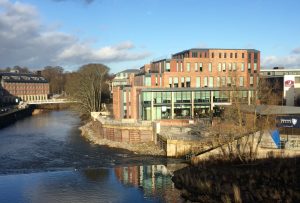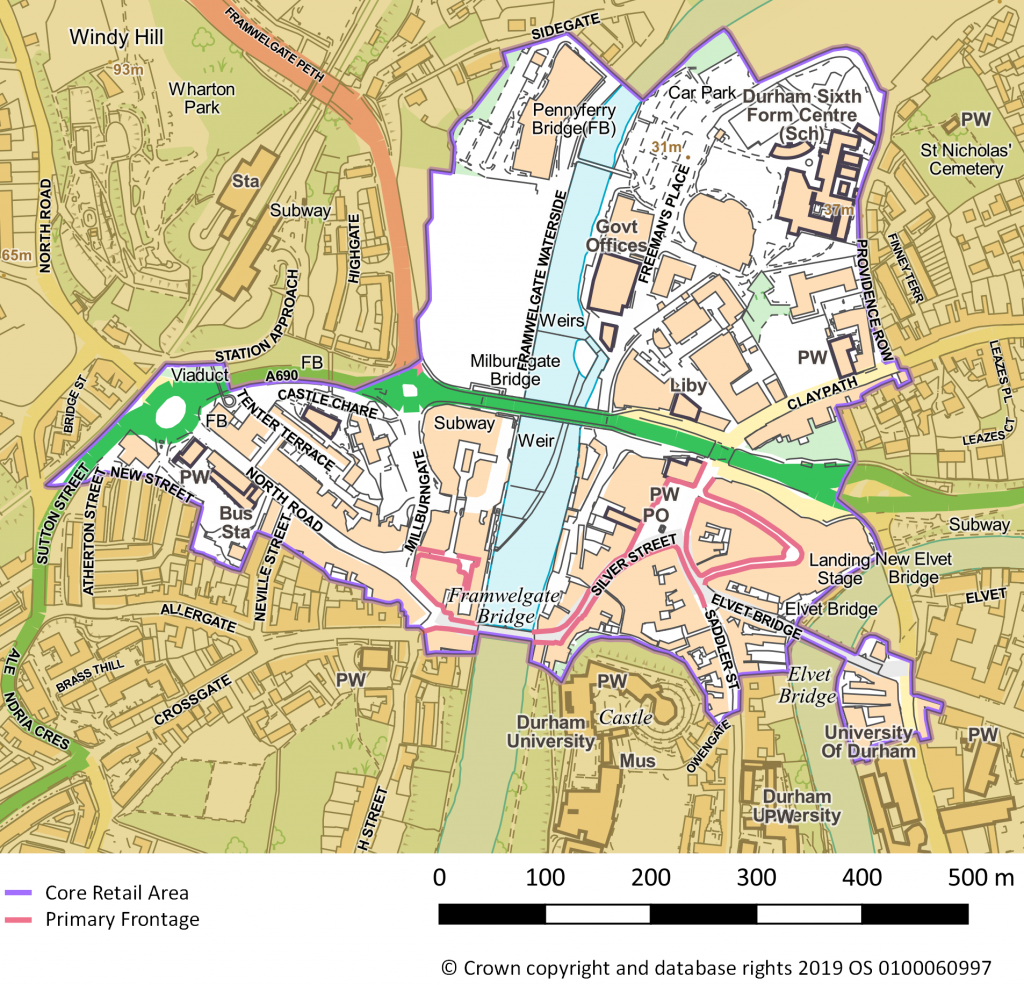Policy E3: Retail Development
Contribute to the creation of a lively and vibrant City centre by development of:
- A1 (retail) as the predominant use;
- development which increases the range and diversity of retail ownerships, and quality of shops and shopping experience for residents, visitors and those working in the City;
- proposals for changes of use of ground floor premises within the Primary Frontage to the following non-A1 uses:
- entertainment
- arts, culture and tourism
- leisure, sport and recreation,
- proposals within the upper floors of Primary Frontage for: retail (A1), financial and professional services (A2), restaurants and cafes (A3), drinking establishments (A4), hot food takeaways (A5), and other appropriate town centre uses (defined as retail, leisure, entertainment, sport and recreation, offices, and arts, culture and tourism). Development proposals that provide residential accommodation in upper floors of commercial properties will be supported, as long as they do not have a negative impact on retail, commercial and tourism activities and the general amenity of neighbouring properties.
Enhance the character and attractiveness of the City centre by:
- ensuring that developments are compatible with the requirements of Policy S1 particularly in respect of their impact on the setting, character, local distinctiveness, views, tranquillity, and the contribution to the sense of place of the World Heritage Site and the Conservation Area;
- ensuring that new development is of a scale, design and character appropriate to the City centre and avoids loss of traditional views of the City: and
- improving the public realm including streets, back lanes, vennels and urban open space for all users; and
- improving the City centre environment and access for pedestrians, cyclists and public transport users including more parking for disabled users.
Policy E4: Evening Economy
Proposals that positively contribute to the evening economy will be supported provided that they contribute to the vitality and viability of the City centre and add to, and improve, the cultural and diversity offer.
4.141 The extent of the shopping area, where new development may be approved, is expected to remain broadly as it is now. However the need to sustain and enhance Durham City centre means that opportunities to improve its retail provision should be taken when they arise through redevelopment and changes of use. The policies reflect the quickly changing retail environment and a need for flexible commercial space to maintain the vitality and viability of the City centre as set out in NPPF (para. 85). The Grimsey Review 2 (Grimsey et al, 2018) a review of retail in Britain states in the Foreword “The fundamental structure of Britain’s town centres has changed from goods transactions to one of consumption of food and experiential services including health and beauty”.
Proposals Map 6: City Centre Boundary and Frontages
4.142 Within the core retail area as defined in Proposals Map 6 there are a number of sites outside the core retail area where planned development will result in an increase of people living or working in the centre. These new developments must ensure that the needs of those living, working or visiting the centre are accommodated: this includes mitigation measures for the generation of additional traffic as stated in transport Policies T1 and T2.
4.143 New developments must be designed to the highest standards and respect and enhance the Conservation Area and the historic City centre. NPPF (para. 124, 125) states the importance of good design in planning. Careful consideration should be given to the access requirements of pedestrians, cyclists, public transport, cars and emergency vehicles in the design and layout of new development. Advice should be available on the design of shop fronts including security blinds for doors and windows.
4.144 There is a deficit of suitable accommodation in the City for young professionals, young couples starting out, people leaving home for the first time and older people. These categories of need are recognised in the NPPF (para. 61). Residential development in Durham City has in recent years been focused on the student market and so-called ‘executive’ housing making it increasingly difficult for residents who fall into one of the categories of need to find suitable accommodation in Our Neighbourhood. The NPPF (para. 118d, 121a) underlines the need to re-purpose existing buildings for use as residential accommodation. Our Neighbourhood Plan seeks to help make Durham City a more balanced community and one in which all residents can benefit, one way in which to do this is to allow the upper floors of Primary Frontage to be used for residential accommodation.
‘executive’ housing making it increasingly difficult for residents who fall into one of the categories of need to find suitable accommodation in Our Neighbourhood. The NPPF (para. 118d, 121a) underlines the need to re-purpose existing buildings for use as residential accommodation. Our Neighbourhood Plan seeks to help make Durham City a more balanced community and one in which all residents can benefit, one way in which to do this is to allow the upper floors of Primary Frontage to be used for residential accommodation.
4.145 Support will be given to any development that contributes to the evening economy, particularly a more diverse cultural offer to redress the over-reliance on restaurants and licensed establishments. In turn this would attract a wider range of visitors including families with children. Park and Ride opening hours should be extended to make the City more accessible in the evening.
Justification for Policies E3 and E4
4.146 The NPPF (para. 85) and the emerging County Durham Local Plan recognise the importance of ensuring the viability and vitality of town centres. The threat to loss of trade in Durham City centre to large retail proposals in nearby centres including out-of-town or edge-of-town centres cannot be resisted through policy in the Neighbourhood Plan as all these rivals are outside its influence. The Retail and Town Centre Study (CBRE, 2018; Durham County Council, 2017a) highlights the threat from out-of-town sites to the retail offer in the City centre. Paragraph 10.3 states that the County Council has been obliged to issue “lawful development certificates” enabling change of use from traditional retail park businesses such as DIY companies to high street fashion chains. Paragraph 10.46 states the negative impact of this course of action on the retail offer in the city; “this could have implications for the future retail strategy of the city as operator demand could be absorbed in out-of-centre locations”. In accordance with the NPPF (para. 86) it is essential that Durham County Council apply a sequential test when considering out-of-town retail proposals across the County so that they do not have an adverse impact on the viability of Durham City centre. The emerging County Durham Plan includes sequential assessment for the protection of the vitality and viability of the City Centre and this coupled with policies and proposals in the Neighbourhood Plan will be crucial in determining such applications and maintaining the retail offer in the City.
4.147 The Primary Frontages are the core retail area of the City centre and where shoppers, visitors and tourists should experience the liveliest and most attractive environment, which will encourage return visits and maintain Durham City’s role in the County’s hierarchy of town centres. The retail sector in Durham City centre is a key driver of the local economy, although it is subject to major seasonal fluctuations because of the impact of Durham University terms and vacations. Durham City has a good mix of shops, including independents and the well-loved market, but the recent closure of BHS and of Marks and Spencer, the anchor stores of the City centre, and a number of other vacant shop units means that it is important that a range of both independent and national retailers are represented to include a balanced mix of consumer goods, food and services within the Primary Frontage. There is growing public concern at the rapid and continuing growth of food shops and in particular cafes, drinking establishments and takeaways which are considered to have a detrimental effect on the overall retail attractiveness of the City. Nevertheless, the food and drink sector plays an important role in the viability and vitality of the City centre which is increasingly apparent following the loss of major stores. There is now a gap in the retail provision in the City centre, which will need an innovative solution to mitigate the challenges currently facing the high street. Enabling more ‘click and collect’, online shopping delivery facilities within City centre shops will help to increase footfall through the City.
4.148 Consumers are now looking for a wider experience when visiting shopping centres. Retail development is now ‘leisure-led development’, that is development which includes cafés, restaurants, cinemas and entertainment facilities such as a bowling alley. A more diverse retail offering in Durham City and entertainment events throughout the year will encourage shoppers to visit and revisit the City centre. Currently Durham City centre “is undergoing transition towards a more mixed retail and leisure development” (CBRE, 2017, para. 10.9; Durham County Council, 2017a) with the transformation of The Gates shopping centre, which it is hoped will encourage visitors to stay longer in the City. Good public transport links are needed between out-of-town shopping areas and the City centre to enable shoppers to access the full range of services, facilities and attractions. The need to upgrade the existing bus station and bus stops serving the City centre is a high priority in improving the attractiveness of the City to shoppers and other visitors. Extending the Park and Ride operating hours would also encourage visitors to stay longer in the City centre.
4.149 There is a lack of affordable retail space in Durham City centre for small start-up businesses and creative businesses. One solution is to use the underused and empty buildings and shops in the City centre. These can be used temporarily for new businesses as they become established. The Government, in a written ministerial statement from the Department of Communities and Local Government on 24th January 2013, highlighted the use of empty shops as a vehicle to maintain the vitality and viability of town centres.
Getting empty town centre buildings back into use:To create opportunities for new and start-up businesses and help retain the viability and vitality of our town centres, we will allow a range of buildings to convert temporarily to a set of alternative uses including shops (Al), financial and professional services (A2), restaurants and cafes (A3) and offices (B1) for up to two years. (UK Parliament, 2013).
4.150 The County Council is addressing the decline in North Road, which has recently suffered from a lack of investment and a deterioration of the retail offer, with improvements to roads and pavements. The Retail and Town Centre Study (CBRE, 2018, para. 10.48; Durham county Council, 2017a) identifies North Road as a regeneration site; “which should be subject to a positive policy framework (not specific retail allocations but more supportive for town centre uses)” This also supports the need for a more flexible approach to town centre uses.
4.151 The retail offer outside the core retail area of Primary Frontage comprises a greater mix of uses including non-retail such as letting agents, cafes and charity shops and these are necessary in order to provide a range of services expected in a town centre. In the case of Durham City the area outside the core retail area has suffered much change over the past 5 to 10 years; and the greater flexibility afforded to commercial premises outwith the core retail area will allow opportunities for smaller retailers, including craft outlets, to add to the character and individuality of the City and contribute to a diverse retail offer.
Next section: Policy E5: Visitor Attractions and Policy E6: Visitor Accommodation


